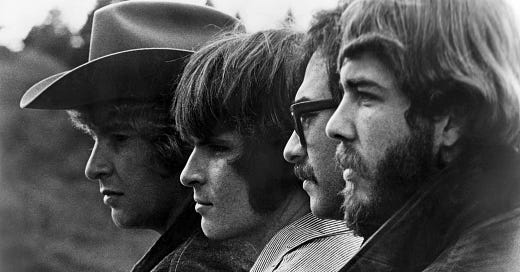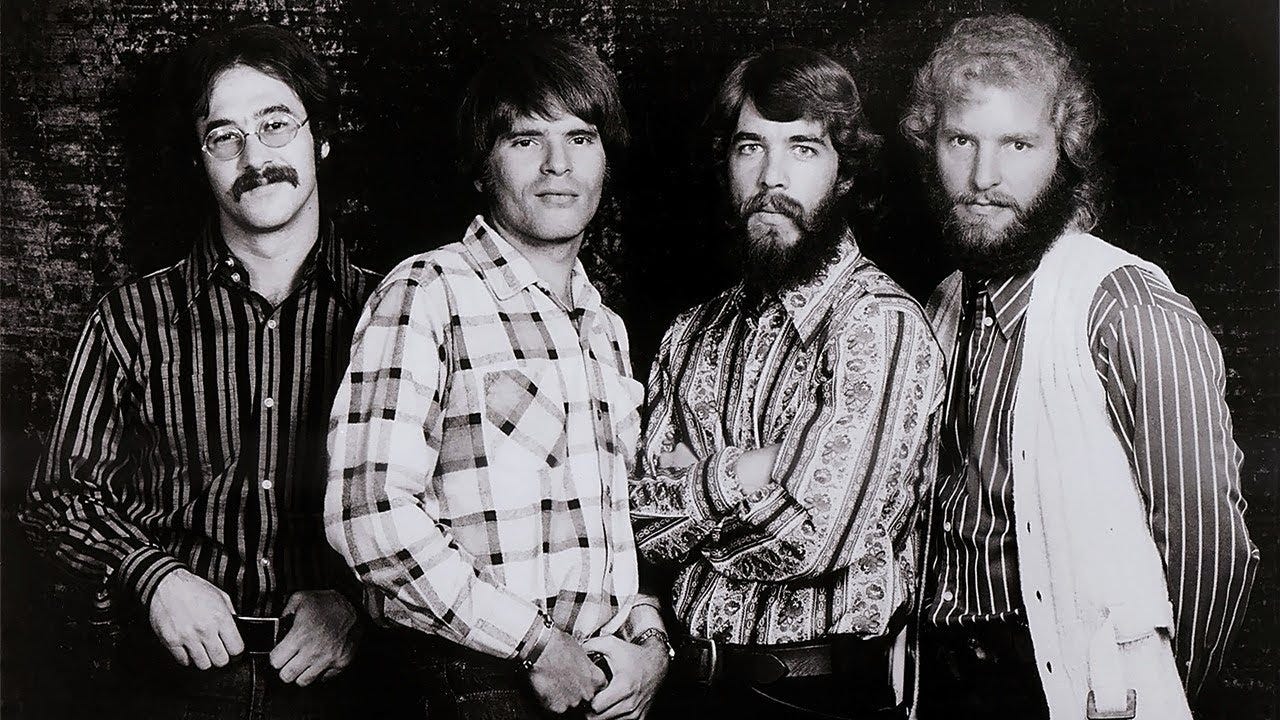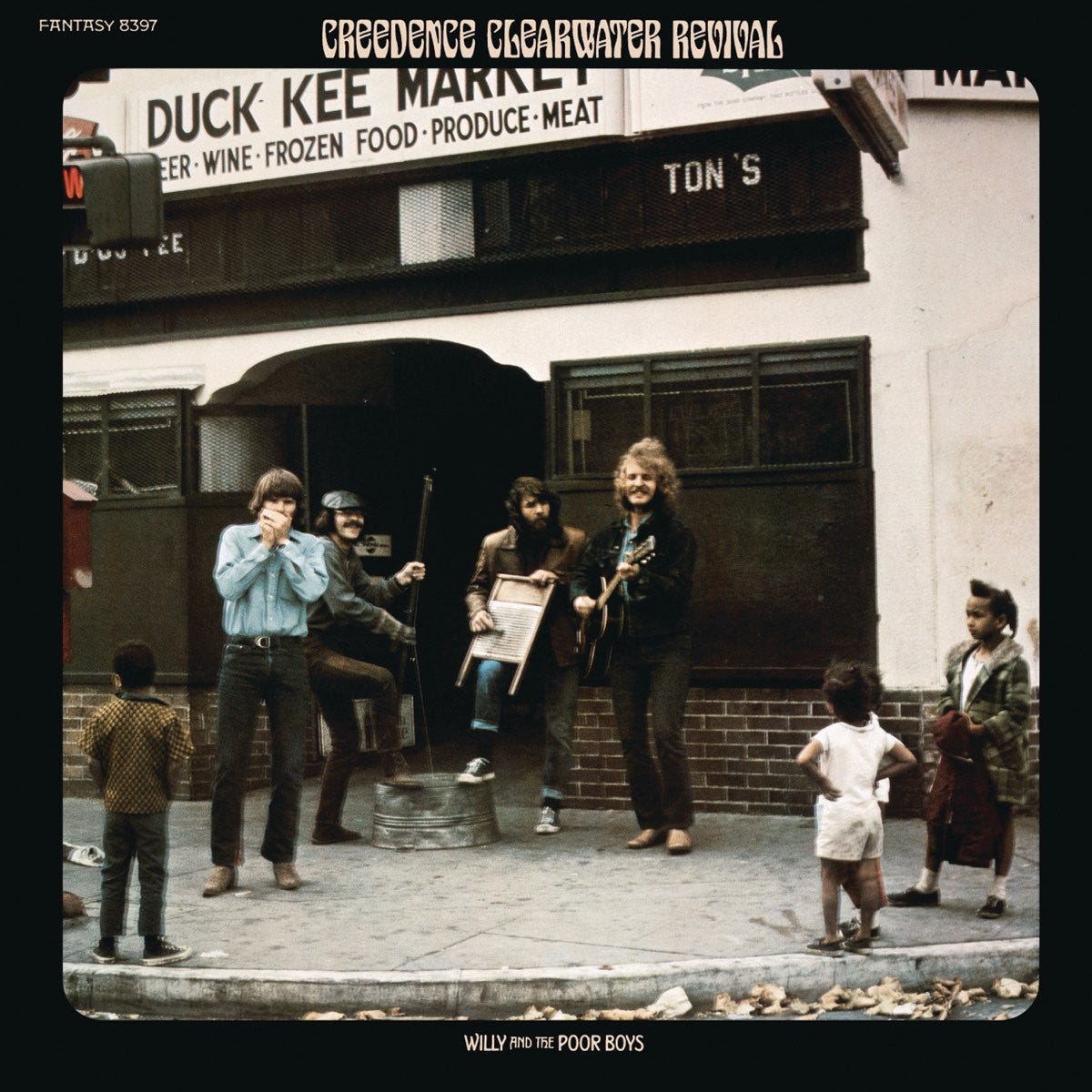Unlocking 'Willie and the Poor Boys': The Album That Shook America"
Discover the explosive truths and hidden messages in CCR's game-changing masterpiece.
What's the Story Behind The Cover?
When you first lay eyes on the album cover of Creedence Clearwater Revival's "Willie and the Poor Boys," you're immediately transported to a different era. The tableau is striking: the band members are busking on a sidewalk, instruments in hand, outside a nondescript Chinese grocery store. It's not just an album cover; it's a snapshot of America in the late 1960s, a social-realist panorama that captures the essence of a nation in flux.
The setting itself is a character in this visual narrative. Why a Chinese grocery store? Why the casual, almost impromptu, busking session? The choice of location was far from arbitrary. It was a deliberate attempt to capture the spirit of grassroots America, a nod to the everyday people who were the backbone of a nation grappling with social and political upheaval. The band members, dressed in everyday clothes, blend seamlessly into this slice-of-life scene, making a statement about their own roots and the community they represent.
But the cover is more than just a picturesque scene; it's laden with symbolism. The band members are not just musicians; they're storytellers, and the sidewalk is their stage. They're the voice of the "poor boys," the underrepresented and the marginalized. "The tableau of the album cover featuring the band members busking outside a Chinese grocery is a depiction of income inequality and cultural bias," says an analysis from The Ringer. The grocery store, a symbol of immigrant America, stands in stark contrast to the band, representing the struggles and aspirations of native-born Americans. It's a juxtaposition that speaks volumes, capturing the complex tapestry of American society.
The public's reaction to the album cover was as layered as the image itself. For some, it was a refreshing departure from the psychedelic and abstract art that adorned many album covers of the time. For others, it was a poignant reminder of the divisions that scarred the American landscape. It resonated because it was real, unfiltered, and deeply relatable. It wasn't just an album cover; it was a mirror held up to America, reflecting both its flaws and its beauty.
How Did The Album Cap Off Creedence Clearwater Revival's Prolific 1969?
1969 was nothing short of a whirlwind year for Creedence Clearwater Revival. The band released not one, not two, but three albums that year, each carving its own niche in the annals of rock history. But it was "Willie and the Poor Boys" that stood as the capstone to a year of frenetic creativity. Released in November, it came on the heels of their first No. 1 LP, "Green River," which had already set the bar exceedingly high. The transition was seamless yet audacious, a testament to the band's artistic vision and unyielding work ethic.
The man behind this relentless drive was none other than John Fogerty, the band's lead vocalist and primary songwriter. Fogerty was a man possessed, churning out eight new songs for "Willie and the Poor Boys," each a masterpiece in its own right. His songwriting prowess was in full display, tackling themes that ranged from political protest to poignant ballads. "John Fogerty's role in writing eight new songs for the album showcased his incredible versatility as a songwriter,"..
But what truly set the album apart was its chart performance. Despite being the third album in a single year—a feat that could easily lead to listener fatigue—the album and its singles performed remarkably well on the charts. It was as if the public's appetite for Creedence Clearwater Revival's music was insatiable. Songs like "Down on the Corner" and "Fortunate Son" not only climbed the charts but also became anthems for a generation.
The recording sessions for "Willie and the Poor Boys" were as legendary as the album itself. The band, fueled by a sense of urgency and a desire to make a lasting impact, poured their heart and soul into each track. The result was an album that was both a commercial success and a critical darling. "The band's tireless year and how 'Willie and the Poor Boys' stands as one of their greatest achievements," states Ultimate Classic Rock, capturing the essence of what made this album a standout in a year of standouts.
In the midst of a year that saw monumental shifts in the musical landscape, from the breakup of The Beatles to the rise of psychedelic rock, "Willie and the Poor Boys" held its own. It was an album that defied trends, that went against the grain, and that stood as a testament to the power of authentic, heartfelt music. It was Creedence Clearwater Revival at their best, unfiltered and unapologetic, capturing the zeitgeist of a nation in turmoil and offering a musical refuge for those in search of something real.
What Makes "Willie and the Poor Boys" a Class-Conscious Album?
In a musical era often defined by psychedelic escapism and abstract lyricism, "Willie and the Poor Boys" stood out as a stark contrast. It was an album deeply rooted in the realities of its time, tackling themes of social inequality, political unrest, and the American Dream—or the lack thereof. The term "class-conscious" might seem like a heavy label to place on a rock album, but in the case of "Willie and the Poor Boys," it's remarkably apt.
The song that most vividly encapsulates this theme is "Fortunate Son," a scathing critique of the American elite who evade the sacrifices that the less fortunate are compelled to make. It's a protest song, but one that goes beyond mere sloganeering. It delves into the systemic issues that perpetuate inequality, making it a rallying cry for those who feel marginalized and unheard. "The themes of class-consciousness in 'Fortunate Son' make it one of the most politically charged songs ever,".
But the album is not a one-note political diatribe. It explores the complexities of American society, reflecting the counterculture and societal divisions of the late 1960s. Songs like "Down on the Corner" offer a more nuanced look at everyday life, capturing the simple joys and struggles of "the poor boys" the album title refers to. It's a celebration of community and grassroots culture, set against the backdrop of a nation in flux.
The album's class-conscious nature is further supported by its musical composition. The blend of rock, country, and blues serves as a musical melting pot, mirroring the diverse social landscape it seeks to represent. "The album reflects the counterculture and societal divisions of the time, making it a class-conscious masterpiece,".
In interviews and statements, the band has often touched upon the themes that pervade the album. While they may not have set out to create a "political" album, the end result is undeniably charged with the social and economic tensions of its era. It's a snapshot of a specific time and place, yet its themes remain eerily relevant, resonating with new generations of listeners who find themselves navigating their own set of societal divisions and class struggles.
The album's enduring appeal lies not just in its musical prowess but in its ability to capture a complex, multifaceted experience of American life. It's an album that asks its listeners to think, to question, and to engage with the world around them. And in doing so, it goes beyond entertainment; it becomes a form of social commentary, a dialogue that continues to evolve even as the world changes around it.






